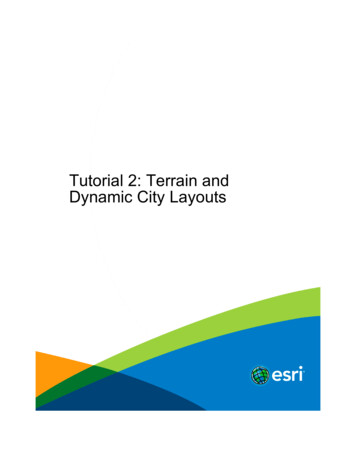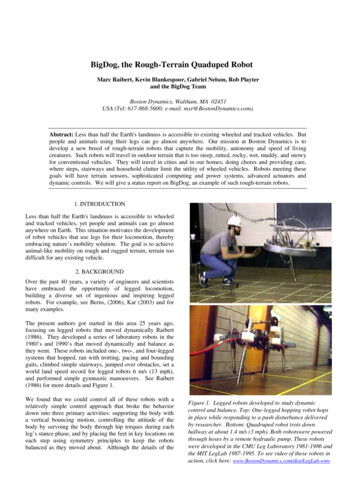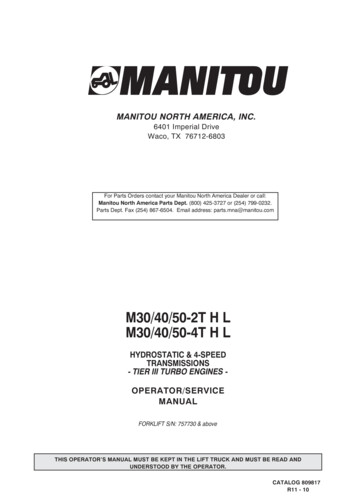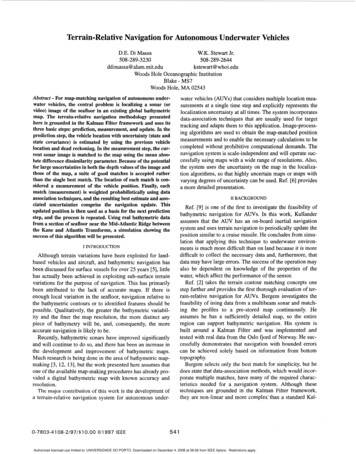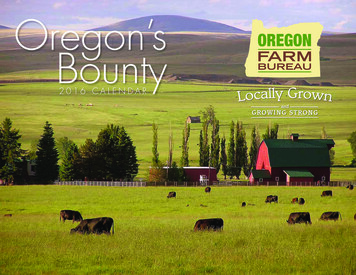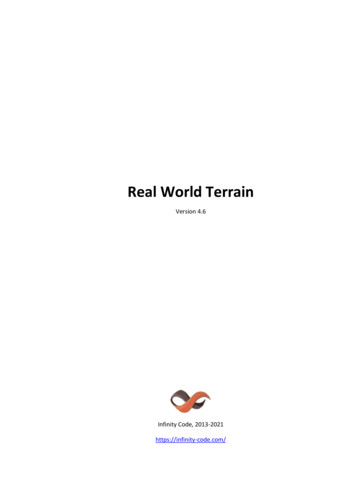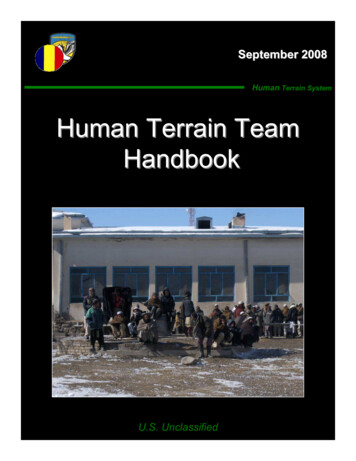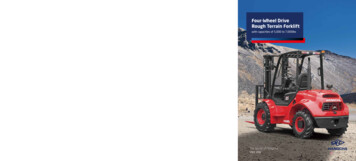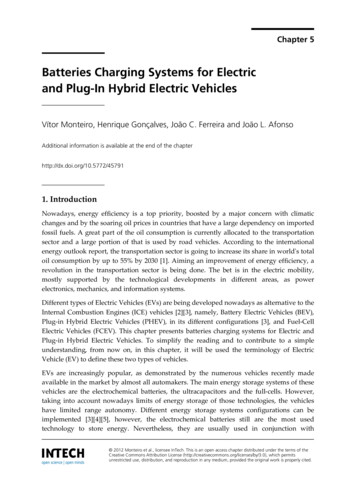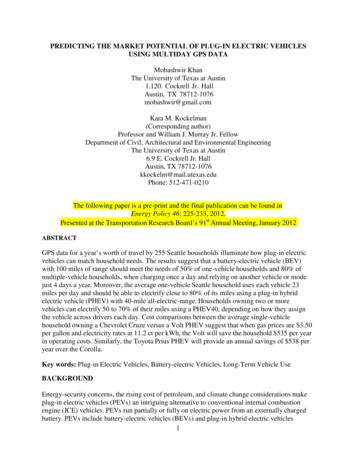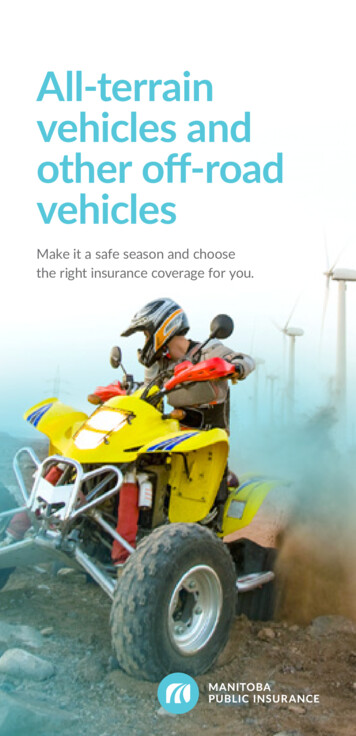
Transcription
All-terrainvehicles andother off-roadvehiclesMake it a safe season and choosethe right insurance coverage for you.
Table of ContentsIntroduction. 1Registering your ORV. 3Insurance protection for you and your family. 6Rules for operating your ORV. 10Riding your ATV safely. 16Riding techniques. 22Additional resources. . 27Pre-ride inspection. 28
IntroductionThis brochure answers key questions about registering,licensing and safely operating an all-terrain vehicle(ATV) or other types of off-road vehicles (ORV).An ORV is defined as any wheeled or trackedmotorized vehicle designed or adapted for off-roaduse. An ATV is an ORV that travels on three or morelow-pressure tires, has a seat designed to be straddledby the operator of the vehicle and has handlebars forsteering the vehicle.Types of ORV include: all-terrain vehicles snowmobiles (For information on registering, licensingand safely operating a snowmobile, see our Snowmobilesbrochure at mpi.mb.ca or visit an Autopac agent.) mini bikes, dirt bikes and trail bikes dune or sport buggies utility task vehicles amphibious vehicles four-wheel drive motor vehicles or motorcycles thatare being driven somewhere other than on a highwayORVs do not include: garden or lawn tractors golf carts infrastructure equipment agriculture equipment1
The rules for registering and operating your ORVare governed by The Drivers and Vehicles Act andThe Off-Road Vehicles Act. These rules are meantto help reduce the risk of a collision.We’ve summarized some of these rules for youin this brochure.We’ve also provided some valuable information to helpkeep you safe while riding.A collision with your ORV can happen. That’s why it’simportant to have enough insurance to minimize thefinancial risks you and your family may face in the eventof an ORV collision. This brochure tells you about thoserisks and the insurance available to reduce them.2
Registering your ORVHow is registering an ORV differentfrom registering a vehicle?You don’t automatically get insurance for injuries or fortheft or damage to your ORV with basic registration. Ifyou want this extra insurance protection, you’ll need tobuy it separately.You get one licence plate, rather than two: For ORVs with three or more wheels and trackedvehicles other than snowmobiles, you must mount iton the rear so that it’s highly visible. For two-wheeled ORVs, you must mount it on the front.How is registering an ORV similarto registering a vehicle?You register your ORV at any Autopac agent in Manitobaor a Manitoba Public Insurance Service Centre.You automatically get third party liability (TPL) coverage( 500,000 for an ORV). In a collision, this covers youagainst other peoples’ claims against you for propertydamage, injury or death. You can also buy more TPLcoverage separately —see “Third party liability” on page 6.TPL coverage does not include coverage for claims forpunitive or exemplary damages. Punitive damages aresometimes awarded by courts as punishment wherereckless behavior is a factor in the accident.You renew your ORV registration and insuranceat the same time as your vehicle.Anyone operating your ORV must carry theregistration/insurance certificate.Your ORV registration comes with a Transfer ofOwnership Document (TOD). If you’re selling yourORV, give the completed TOD to the buyer.3
If you’re disposing of your old ORV and replacing itwith a new ORV, you have seven days to register thenew ORV. During this seven-day period, your existingcoverage and registration will apply to your new ORV.When transferring your registration and insurance toanother ORV, a transfer fee applies and your insurancepremium may change.If you’re disposing of your old ORV without replacing itwith a new ORV, you must take your licence plate andregistration/insurance certificate to an Autopac agent.You must report an address change within 15 daysto an Autopac agent or a Manitoba Public InsuranceService Centre. You can also submit your change bymail to: Manitoba Public Insurance, 234 Donald Street,Box 6300, Winnipeg, MB R3C 4A4.You must be at least 16 years of age to register an ORV.You must provide proof of your age (birth certificateor other identification). If you’re under 18, you needwritten permission from your parent or legal guardian.4
Are there some situations when anORV doesn’t have to be registered?Yes. You don’t need to register your ORV if any of thefollowing apply: you operate it only on your own property you don’t live in Manitoba and it’s currently registeredin your home province or territory it’s a motor vehicle registered under The Drivers andVehicles Act you’re a commercially-licensed fisher using your ORVfor your fishing business or you’re a licensed trapperusing your ORV in a registered trapline district orspecial trapping area it’s owned and operated on behalf of the Departmentof National Defence and displays a licence plate orother identification from that department you’re an ORV dealer who either owns or possessesan ORV and you use a dealer plate. you live in a remote community and operate your ORVonly within that community5
Insurance protection for youand your familyWhat financial risks could you facewith your ORV?Your injuriesRegistering your ORV doesn’t automatically give youinjury coverage. If you cause a collision, you will notreceive coverage for your own injuries.If you’re in a collision and the other driver is atfault, you may claim against the other driver’s thirdparty liability insurance and, in some cases, yourunderinsured motorist coverage.This is often not enough and could leave you having topay for any costs from medical treatments, disability,permanent impairment and more if you or a familymember were injured while riding. The Personal InjuryProtection Plan (PIPP), which covers automobile injuries,covers ORV riders in one situation only — if the ORVcollides with a moving automobile.Claims others may make against youIf you cause an injury or damage property whileoperating your ORV you can be sued. With yourregistration you have 500,000 third party liabilityprotection for someone else’s claim against you.That may not be enough to cover you against aserious claim. Covering the claim yourself couldresult in financial hardship.Your own machineWhen you register your ORV, you do not automaticallyget coverage for damage to your machine or for theft.Could you afford to lose your machine without anycompensation?6
What insurance options can you buyto protect yourself, your family andyour ORV against these risks?Accident benefitsAccident benefits help cover costs resulting frominjury, including disability, medical treatment andrehabilitation. Benefits paid are the same regardless offault. With the accident benefits policy you’re insuredfor your injuries or death from: operating or riding on any ORV, including collidingwith something getting on or off any ORV being run over or struck down by any ORVIf you’re operating someone else’s ORV, you must havethe owner’s permission.In addition, other operators or occupants of yourORV are insured for their injuries or death from: operating or riding on your ORV, including collidingwith something getting on or off your ORV being run over or struck down by any ORVTo be covered, others operating your ORV must have yourpermission. If you’re riding outside Manitoba (but withinCanada or the United States), others operating or riding onyour ORV must also be Manitoba residents.Third party liabilityOur Third Party Liability Plus coverage offers two-wayliability protection against: claims someone makes against you for propertydamage or injuries other ORV operators who don’t have sufficient liabilityinsurance to cover your injury claimYou can choose from three levels of coverage: 1 million, 2 million or 5 million. This also includesthe same amount of underinsured motorist protection.7
Remember: if you injure others — including yourpassengers — or damage their property, they can sue you.Additional third party liability options do not includecoverage for claims for punitive or exemplary damages,as these are not covered under third party liability.Punitive damages are sometimes awarded by courtsas punishment where reckless behavior is a factor inthe accident.Collision protectionCollision protection covers damage to your ORVcaused by a collision. You can choose from eithera 200 or 500 deductible.8
Comprehensive protectionComprehensive protection covers physical damage toyour ORV from causes other than collision, such as fire,theft, vandalism and hail. You can choose from either a 200 or 500 deductible.Combining collision and comprehensive protection givesyou the most protection we offer against damage to, ortheft of, your ORV. Before selling you this coverage, yourAutopac agent may need to inspect your ORV.Ask an Autopac agent for more details about thesedifferent coverages. Some restrictions may apply.With all our ORV coverages, you renew on the sameschedule as the rest of your Autopac.Your coverage begins as soon as you apply and lastsyear-round, but you only pay during the riding season.Keeping your coverage year-round gives you continuousfinancial protection. It also ensures you won’t need tohave your ORV reinspected.Reporting an ORV collisionA collision should be reported to Manitoba PublicInsurance the same way it would be if it involved yourvehicle. For more information, check the “When youhave a claim” section in your Guide to Autopac or callus at 204-985-7000 (in Winnipeg) or 1-800-665-2410(toll-free outside Winnipeg).We can assist you in determining if you need to makea police report when you call to make a claim.9
Rules for operating your ORVAge requirementsUnder 14 years of ageYou can operate an ORV only under the directsupervision of your parent/legal guardian or a personover the age of 18 authorized by your parent/legalguardian. You can travel in ditches but you cannotcross or travel on roadways, shoulders or sidewalks.14 years of age (without a valid driver’s licence)You can operate an ORV unsupervised.* You can travelin ditches but you cannot cross or travel on roadways,shoulders or sidewalks.15M years of age(with a valid Learner Stage driver’s licence)You can operate an ORV unsupervised.* You can travelin ditches but you cannot cross or travel on roadways,shoulders or sidewalks.16 years of age (with a valid Intermediateor Full Stage driver’s licence)You can operate an ORV anywhere that ORV use ispermitted as long as you follow the rules laid out inThe Off-Road Vehicles Act. Many of those rules aredescribed in this brochure.Manufacturers may provide a minimum agerecommendation that should be followed. This does notoverride the requirements of The Off-Road Vehicles Act.*Except a motorcycle or four-wheel drive vehicle that is eligible forregistration under The Drivers and Vehicles Act.10
Helmet useWith a few exceptions, ORV riders must always wearan approved safety helmet. Full face helmets helpprotect your face as well as your head. Open facehelmets are lighter and cooler but should be used witheye and mouth protection. Safety helmets must meetall the requirements of one of the following standards: Snell Memorial Foundation “Standard for ProtectiveHeadgear”, bearing the certificate of the SnellMemorial Foundation United States of America “Federal Motor VehicleSafety Standard 218”, bearing the symbol DOT United Nations Economic Commission for EuropeRegulation No. 22 (ECE 22) “Protective Helmets andof their Visors”You don’t have to wear a helmet if any of thefollowing apply: you’re a self-employed farmer, commercial fisher,hunter or trapper riding an ORV while working atyour occupation you live in a remote community and operate yourORV only within that community your ORV has rollover protection and seatbelts whichanyone riding your ORV must wear you’re working for Manitoba Hydro and riding anORV to service tower lines north of the 53rd parallelbetween May 1 and Oct. 31 you’re enforcing The Wildlife Act or The Fisheries Actor respective regulationsWe still recommend wearing a helmet at all times,even if it’s not required.Seatbelt useEvery operator and passenger of an ORV in whichseatbelts are provided should wear a complete seatbeltthat is properly adjusted and securely fastened.11
Headlights and tail lightsThere needs to be at least one white headlamp andone red tail light in working order. At minimum, lightsshould be on from one-half hour before sunset untilone-half hour after sunrise and any other time whenvisibility is reduced to 60 metres or less.TowingWhen towing another ORV, trailer, sleigh, cutter,toboggan or other apparatus that can be towed ordrawn, you must use a rigid tow bar that keeps theback of your ORV and the front of what is being towedno more than three metres apart.An ORV cannot tow another vehicle across a roadwayif the towed vehicle is carrying a person. The exceptionto the law is if the person on the towed vehicle is notable to walk or the towed vehicle is disabled and needsa person to steer it.Before towing anything, read the owner’s manual tomake sure your ORV can be used for towing. Keep inmind that only experienced riders should tow anythingand that towing will affect your vehicle’s handling andbraking ability.12
Where you can and cannot rideRoadways you must not ride on a roadway you can cross a roadway at or within five metres of anintersection if you hold a valid driver’s licence, otherthan a learner’s permit when intersections are more than three kilometres apartyou can cross at any other point along the highway aslong as you have a clear view of oncoming traffic if in a group, only one ORV can cross at a time before crossing a roadway, you must stop and yield topedestrians and approaching trafficRoadway shouldersYou cannot ride on the shoulder of a roadway exceptunder all of these conditions: the ORV you’re riding has more than two wheels andyou’re using it for agricultural purposes the ORV you’re riding is displaying ‘slow moving vehicle’signs on the rear you drive 40 km/h or less you hold a valid driver’s licence, other than alearner’s permit you drive on the right-side shoulder in the samedirection as traffic13
MediansYou must not ride on or across the median of adivided highway.Designated Crown landCrown land is land administered by the provincial andfederal governments. Although most Crown land isavailable for everyone to enjoy, access to some areasis restricted for environmental reasons or publicsafety concerns.In Crown land areas where ORVs are permissible, pleasebe respectful and responsible. Stay away from crops,gated rangeland, plantations and environmentallysensitive areas such as beaches, sand dunes, riparianareas and wetlands.14
DitchesIf your ORV is a four-wheel drive motor vehicle thatcan be registered under The Drivers and Vehicles Act,you must not drive it in ditches. You can ride all othertypes of ORVs in ditches only if: the ditch is to the right of the roadway and the shoulder you travel in the same direction as vehicle traffic you’re operating in an area where ORV use is allowedUse great caution when travelling in ditches—watchout for roads and driveways, culverts, road signs andother hazards.Parking lotsYou can drive your ORV in a parking lot to: travel to where you’ll be using your ORV return to the vehicle that brought your ORVto the parking lotPrivate land and dwellingsYou must not operate an ORV: on privately-owned or leased land without the owner/occupier’s permission within 30 metres of a dwelling between midnight and7:00 a.m., unless the dwelling is on your own propertyor you’re an invited guest, or the dwelling is underyour control within 30 metres of a playground or area set aside forrecreation, unless it’s fenced or you’re using the ORVfor maintenance or operation of the area15
Riding your ATV safelyAlthough most ORV owners ride responsibly, morethan 100 Manitobans are injured or killed in ORVcollisions each year. Operating an ORV safely involvesmore than just following the rules in this brochure.They are powerful machines that have the potential tocause serious injury or death.That’s particularly true of all-terrain vehicles (ATVs).When ridden responsibly, ATVs provide safe andexciting opportunities for families and groups to enjoythe outdoors.Enjoy a safe ride by following these tips for operatingyour ATV:Eye protectionEye protection should be used with full face or openface helmets. Regular sunglasses do not provideadequate protection on an ATV. A face shield orgoggles will better protect you.Eye protection should be: free from scratches shatterproof securely fastened well-ventilated to tinted for riding onbright days or clearfor night riding oryellow for overcast daysprevent fogging16
Protective clothingBootsOff-road boots are best as they offer protection forlower legs, ankles and feet and they help prevent yourfeet from slipping off the footrests.GlovesGloves prevent your hands from getting sore, tired orcold and offer protection in the event of a spill. For bestprotection use gloves with padded knuckles and palms.ClothingLong pants and a long-sleeved shirt or jacket canprotect your skin from scratches as well as weatherextremes. For best protection wear off-road riding gearthat includes pants with kneepads and a shirt withchest and shoulder protectors.It’s important to dress for the weather and lengthof your trip. Do not wear loose clothing that can becaught in the ATV or clothing that won’t keep youwarm enough.PassengersMultiple passengers are a factor in many injuries andfatalities. Don’t ride with passengers unless your ATVis specifically designed to hold more than one person.Carrying passengers is unsafe as it disrupts the balanceand stability of the machine.Trail etiquetteRide only on trails where ATV use is allowed and berespectful to everyone you come across.Remember to: keep to the right slow down when passing people or animals yield to uphill traffic17
Private propertyRespect riding area rules and ride only wherepermitted. Remember to: always ask permission to cross private property comply with signs and fences leave gates as you find themHand signalsCommunicating while riding can be a challenge. Handsignals are an effective solution. Learn how to usethem at www.ccso-ccom.ca/en/hand-signals/.18
Be sensitive to habitatsPreserve the environment; leave it better than youfound it. Remember to: carry out what you carry in stay away from environmentally-sensitive areas andwetlands avoid nesting areas and yield the trail to any wildlife stay on the trail and away from areas that are easilydamaged by churning wheels clean your ATV after each trip to avoid possiblytransferring invasive plant or animal species toother areas (for more information visit gov.mb.ca/waterstewardship/stopais)Avoid fire riskBe aware of when the risk of forest fires is higherthan normal.When conditions are dry in areas where you’re riding,use caution as sparks from your ATV could ignite grass,branches or other combustible material.Stop frequently to check areas around the engineand exhaust for debris, and carefully dispose of anydebris found.Carry a small shovel, axe and fire extinguisher on yourATV at all times.Report all wildfires by calling 1-800-782-0076.Alcohol and drugsSkills such as visual sharpness, reaction time, judgmentand general awareness are critical to an ATV operatorwhile riding. These skills are greatly hindered byalcohol, marijuana and illegal drugs.As well, many prescription or over-the-counter drugs,such as cold tablets and allergy medications,can have an adverse effect on your driving skills.Read all warning labels and understand the effects thesedrugs have on your ability to operate your ATV safely.19
Know the consequencesof impaired drivingManitoba’s impaired driving laws apply to theoperation of all motorized vehicles, including ORVs.If you operate a motor vehicle with a blood alcoholconcentration between .05 and .079, register a warnon an approved screening device (ASD), or fail adrug screening test, physical coordination test ordrug recognition evaluation, you are subject to animmediate Tiered Administrative Licence Suspensionranging from 72 hours to 60 days. You will also movefive levels down the Driver Safety Rating scale and berequired to pay a driver’s licence reinstatement charge.If you register a warn on an ASD, you will alsoface enhanced roadside sanctions, including anadministrative penalty and vehicle impoundment ona first offence. Sanctions increase with subsequentoffences.You will receive a three-month Administrative LicenceSuspension if: your blood alcohol concentration is equal to or over .08 you register a fail on an ASD your blood drug concentration is over five nanograms(ng) of THC your combined blood alcohol concentration is over.05 and your blood drug concentration is more than2.5 ng of THC you refuse to provide a breath, saliva or blood sampleto police you refuse to perform a physical coordination testor drug recognition evaluation, or refuse to follow apolice officer’s instructions regarding either test you have any concentration of illegal drugs inyour systemYou will also move five levels down the Driver SafetyRating scale and be required to pay a driver’s licencereinstatement charge. Additional consequences include: potential charges under the Criminal Code20
vehicle impoundment a mandatory Impaired Driver Assessment at thedriver’s expense participation in Manitoba’s Ignition Interlock ProgramIf you fail or refuse an ASD, you may face enhancedroadside sanctions, including an administrative penalty,vehicle impoundment, mandatory Ignition Interlockparticipation for one year, and movement of 10 levelsdown the Driver Safety Rating scale.If you are convicted of an impaired driving-relatedCriminal Code offence, you will face sanctions such as: moving an additional five, 10 or 15 levels down theDriver Safety Rating scale a court-imposed fine possible imprisonment a court-imposed driving prohibition mandatory driver’s licence suspension underThe Highway Traffic Act participation in Manitoba’s Ignition Interlock Program possible vehicle forfeitureIn addition to being unsafe, the following activities canresult in your insurance coverage being denied: driving your ORV while intoxicated driving your ORV while committing criminal activity permitting a criminal act on your ORV operating your ORV without a licence, where one isrequired operating your ORV with a suspended licence using your ORV for prohibited trade or transportation using your ORV for a speed test or race attaching a trailer to your ORV without the properregistration using your ORV to escape police or avoid arrest21
Riding techniquesTo ride safely, you need to be able to assess the terrainahead of you and understand the capabilities of yourmachine.Stay on existing trails. Avoid dangerous terrain such assteep slopes, marshes and swamps.Travel at speeds appropriate for the terrain, visibility,operating conditions and your ability.Constantly scan the path ahead of you to pick thesafest route around large holes, ruts, bumps, guy wires,railway tracks, culverts, fences, posts, debris and otherobstacles or hazards.Carefully approach hills, turns and other obstacles.Be especially alert when travelling over unfamiliar terrain.Riding over boardwalks and decks can be dangerous asthey are often built over wetlands and can be slippery.Cross these structures with extreme caution.22
Turning basicsConsult your manual for information on turning yourATV properly. In general, you should: turn at low-to-medium speeds move forward on the seat and lean in the directionof the turn turn the handlebars while looking where you’re turning speed up slightly as you come out of the turn if the ATV starts to tip, lean your body farther intothe turn and gradually reduce your speedStopping quicklyWith the possibility of ever-changing terrain, fallentrees or animals, you should be prepared to stopquickly. A quick stop may be necessary at any time,so remember to: ride within your ability use both brakes when stopping if you lock the wheels, release the brakes momentarilyand reapply them more gradually slow your ATV when cresting a hill or goingthrough a turn keep your feet on the footrests23
Riding up hillsClimbing hills can be dangerous if you don’t follow theproper procedures described in your owner’s manual.You could lose control of your ATV or it could overturn.In general, you should: Use good judgment. If the hill looks too steep for yourATV or your abilities, it probably is. Start the climb by shifting into a lower gear. Speed upto maintain momentum. Move up on the seat and lean forward or stand andposition your torso over the front wheels. Keep your weight uphill at all times and your feet onthe footrests. If you are riding uphill and lose all forward momentum: Keep your weight forward but apply both brakes tocome to a stop. Don’t let the ATV roll backwards. If the ATV does start to roll backwards, apply theparking brake and get off on the higher side of theATV if the ground is uneven.If you can’t see what is on or over the crest of a hill,slow down until you have a clear view.24
Riding downhillAlways carefully check the terrain before you startdown any hill. Choose a downhill path that is asstraight as possible with minimal obstacles.When going downhill, remember to: shift your weight to the rear maintain a low speed use a lower gear brake gradually look aheadRiding across a slopeYou may encounter hills that are too steep to ascend ordescend in a straight line. In those situations you maybe able to drive across the slope at an angle. Do notride on slippery, rough or loose surfaces. When riding,be sure to: keep both feet firmly on the footrests lean your upper body uphill keep your speed steady and avoid making suddenthrottle changes25
Riding in sandAlways remember: make sure you have an antenna flag so others can seeyou better dunes shift in size and shape and can change quickly,so never assume what you rode on one day will be thesame the next when riding up a dune, be prepared to make a U-turnif there is a drop-off wet sand is unstable, so do not drive on wet sandunless you know it is safe when stopping, only stop on a crest or where you’revisible to others avoid riding on vegetation as it helps stabilize thedunes and may also hide an obstacle or hazard be extra careful when the sun is directly overheadbecause there are no shadows to indicate holes,drop-offs or changes in terrain a gradient (dark at top and clear at bottom) or darklens in your goggles can help distinguish dips, dropsand holes in the sandRiding through mud and waterAvoid water crossings where you might cause damageto stream beds, stream banks and fish habitats suchas spawning and nursery grounds or where you mightcause erosion to the banks of streams or creeks.If you must cross a stream or go up and down streambanks, use an established crossing or ride where thebanks have a gradual incline. Note that fish habitatsare often found at crossings.Water levels may change from hour to hour so it isimportant to safely determine the depth of the wateror mud before riding through it.Do not operate your ATV in fast-flowing water or inwater deeper than that specified in your owner’s manual.26
Your body position is very important when riding inmud or water; to maintain proper balance or maximumtraction be prepared to shift your weight in any direction.Wet brakes may have reduced stopping ability; alwaystest your brakes after leaving water.Do not spin tires quickly; they will only dig holes andsplatter you with mud — you will not travel any faster.After riding in water, be sure to drain any trapped waterby removing the drain screws (if equipped). Do not drainwater from one body of water into another — you maymove invasive species without knowing it.Do not attempt to ride over frozen waterways orthin ice, as it is extremely dangerous.Using a trailerIt is important to get your ATV safely to your ridingdestination. This means making sure your ATV traileris properly secured to your vehicle and the ATV isproperly secured to the trailer. You must also makesure that your trailer complies with all regulations ofThe Highway Traffic Act.Additional resourcesRiders are encouraged to join local clubs and takea riding lesson. For a list of clubs in your area visitatvmb.ca/clubs.Safety Services Manitoba provides freepresentations to high schools and communitygroups on riding ATVs safely. Call 204-949-1085or visit safetyservicesmanitoba.ca.27
Pre-ride inspectionTires and wheels Always maintain the recommended tire pressure. Check for cuts or gouges that could cause air leakage. Make sure axle nuts are tightened and secured by cotter pins.Controls Make sure the throttle moves smoothly and snapsclosed with the handlebars in any position. Make sure the brakes operate smoothly and areadjusted according to the owner’s manual. Make sure the foot shifter is firmly attached andpositioned for safe operation.Lights and switches Check the position of the ignition switch (if equipped)and make sure it works by switching it on and offduring your warm-up. Be sure the engine stop switch turns off the engine. Ensure all lights (if equipped) are working.Oil and fuel Ensure you have e
registration/insurance certificate to an Autopac agent. You must report an address change within 15 days to an Autopac agent or a Manitoba Public Insurance Service Centre. You can also submit your change by mail to: Manitoba Public Insurance, 234 Donald Street, Box 6300, Winnipeg, MB R3C 4A4. You must be at least 16 years of age to register an ORV.
